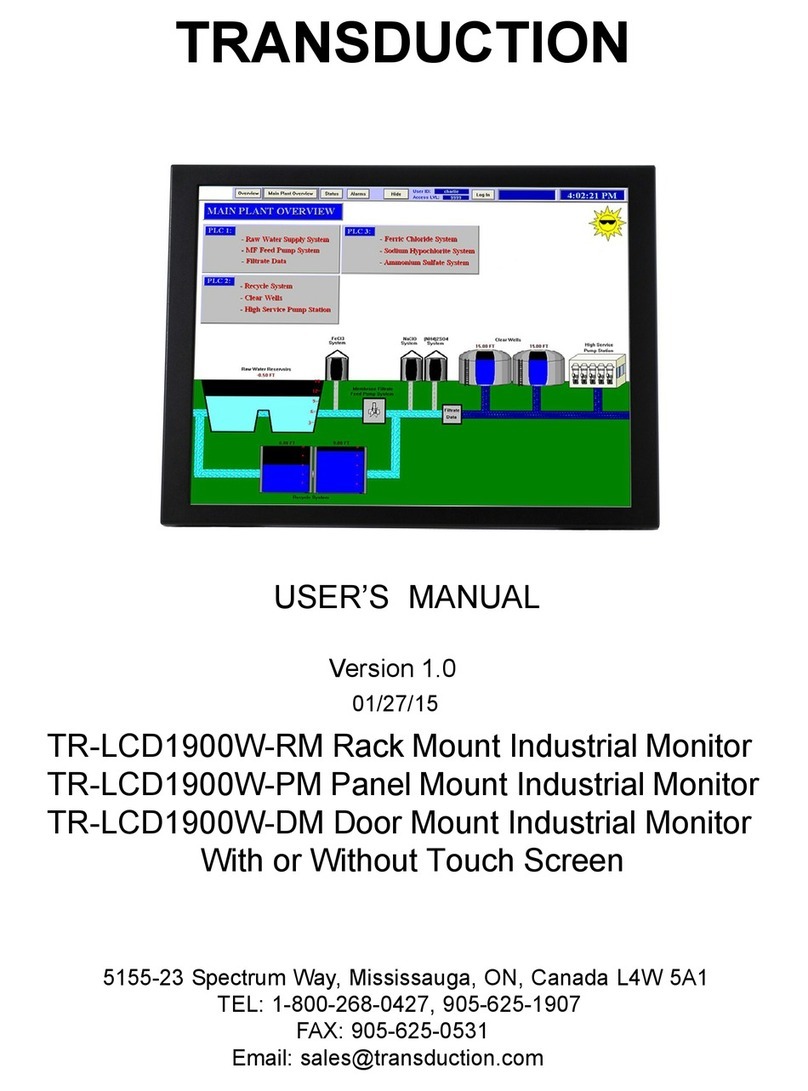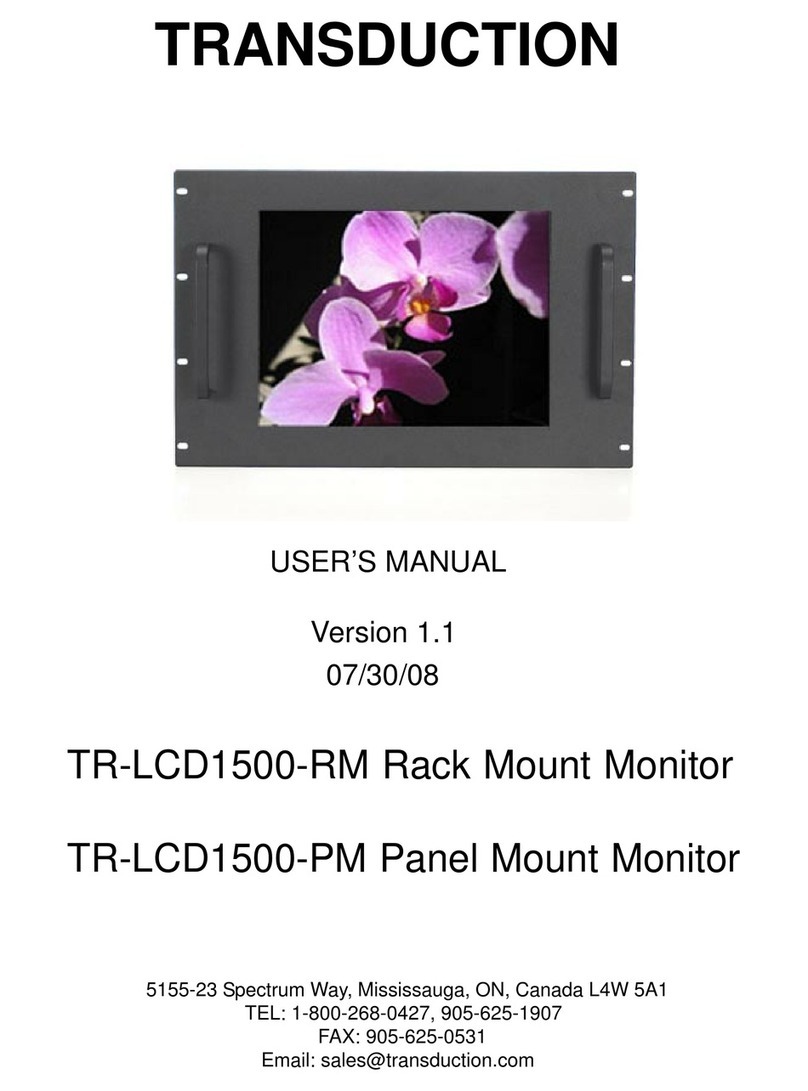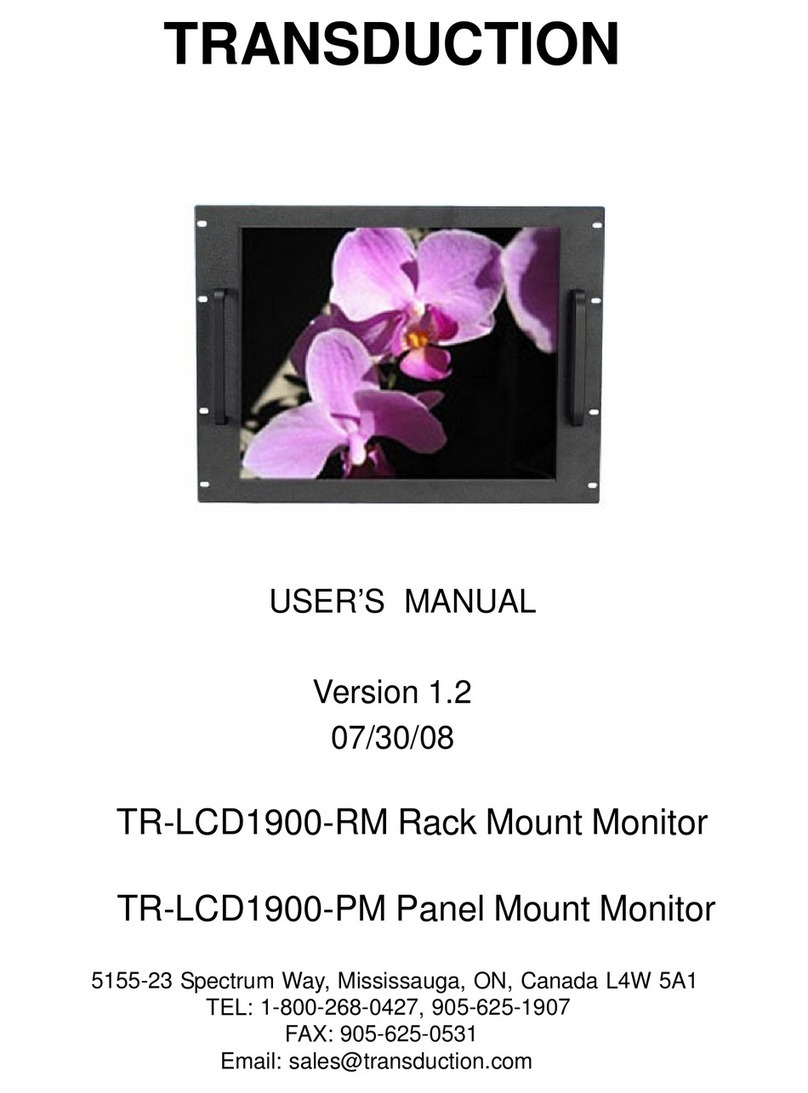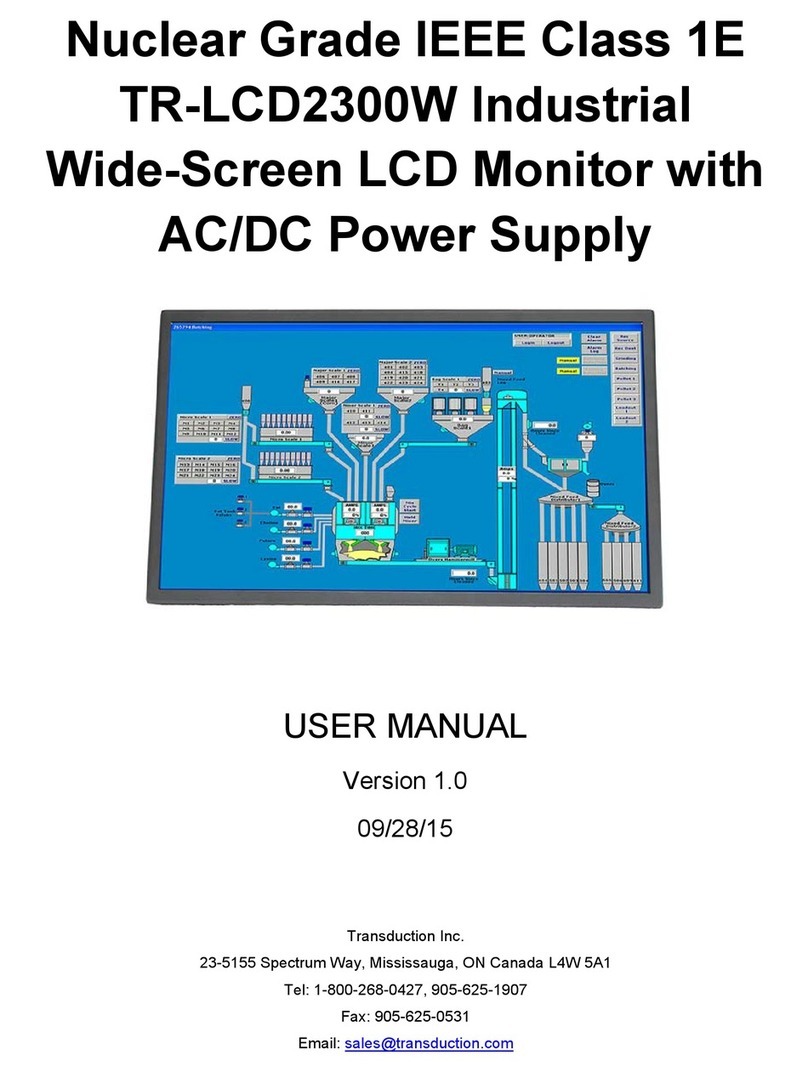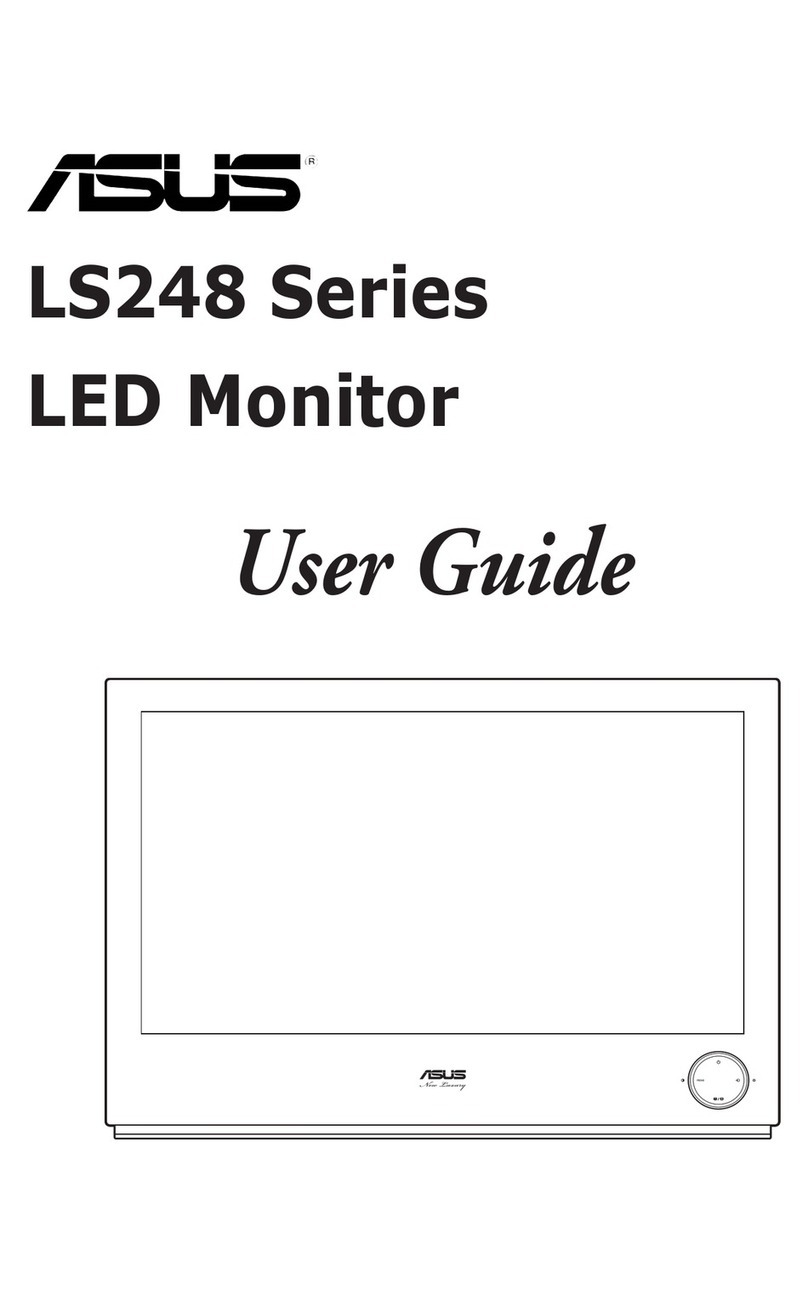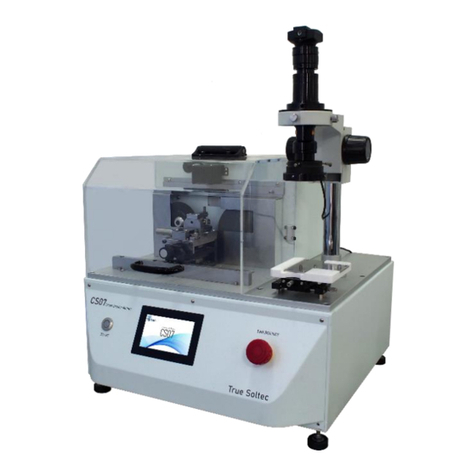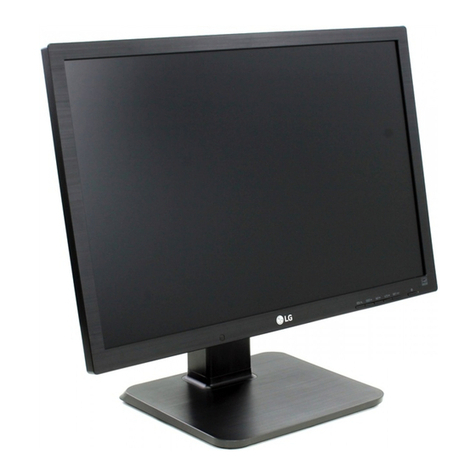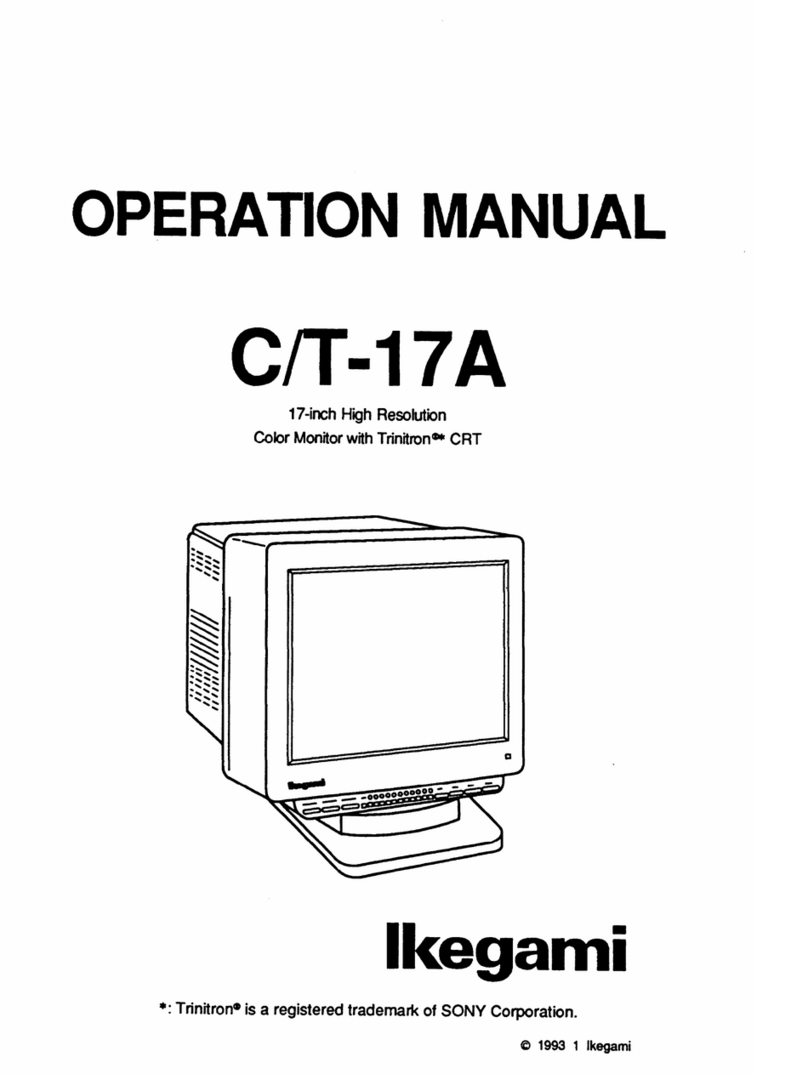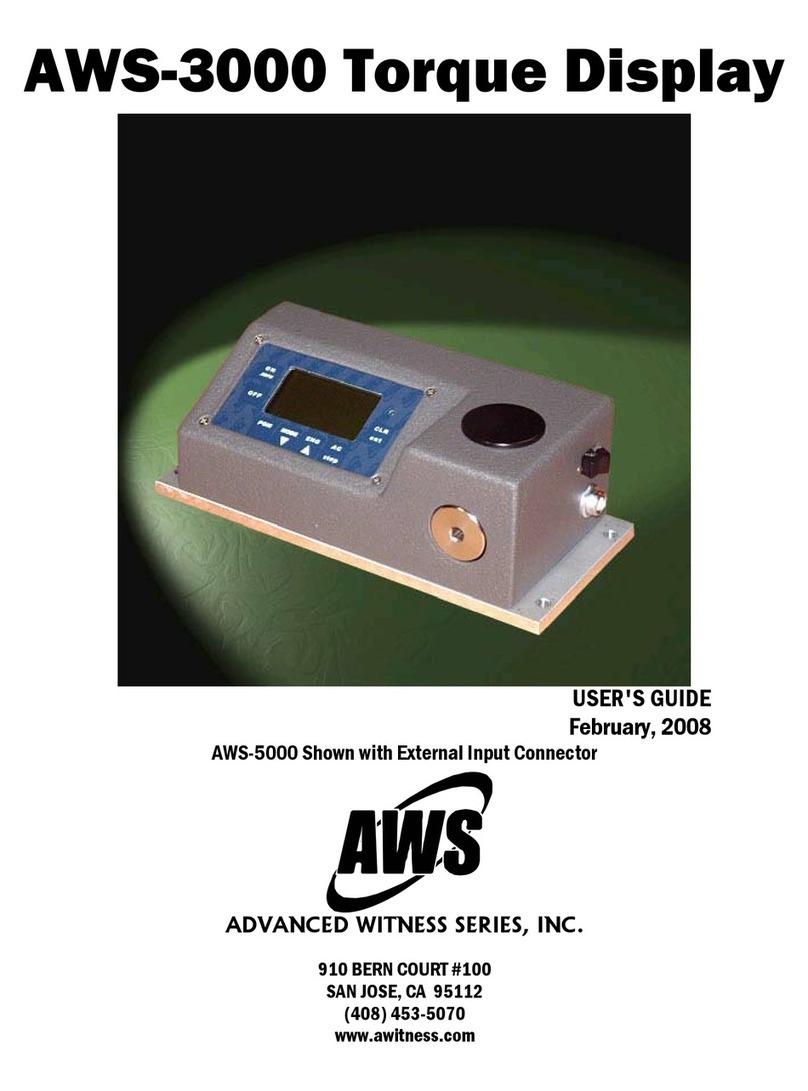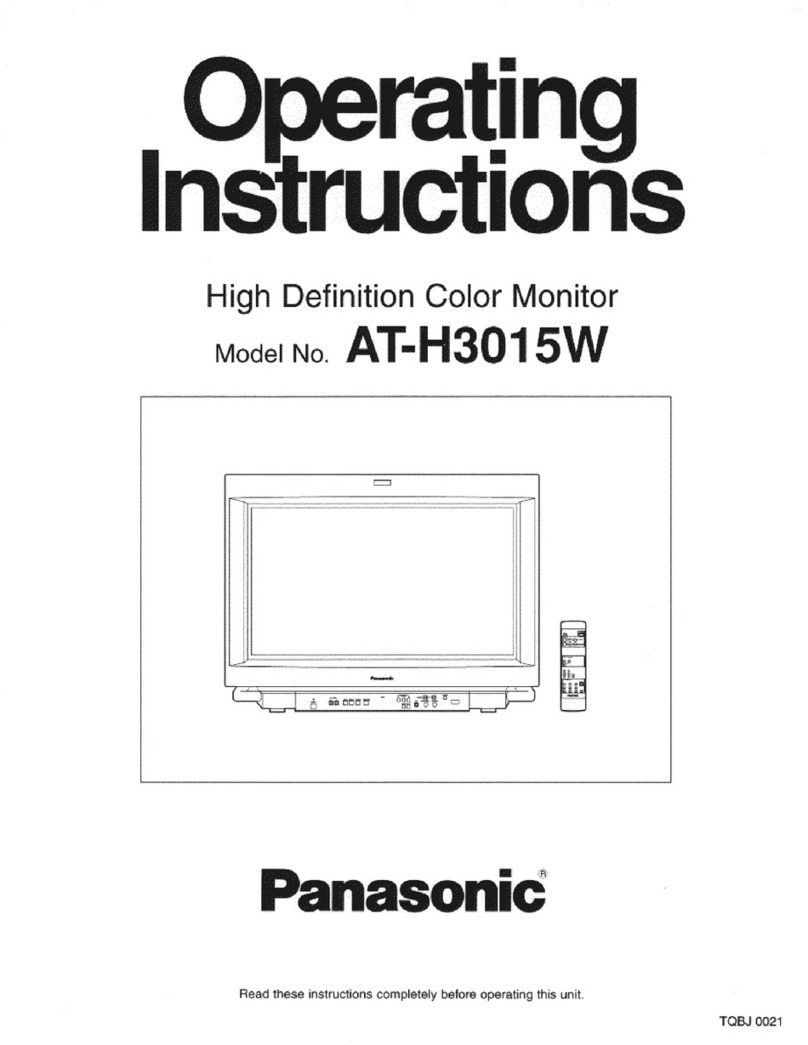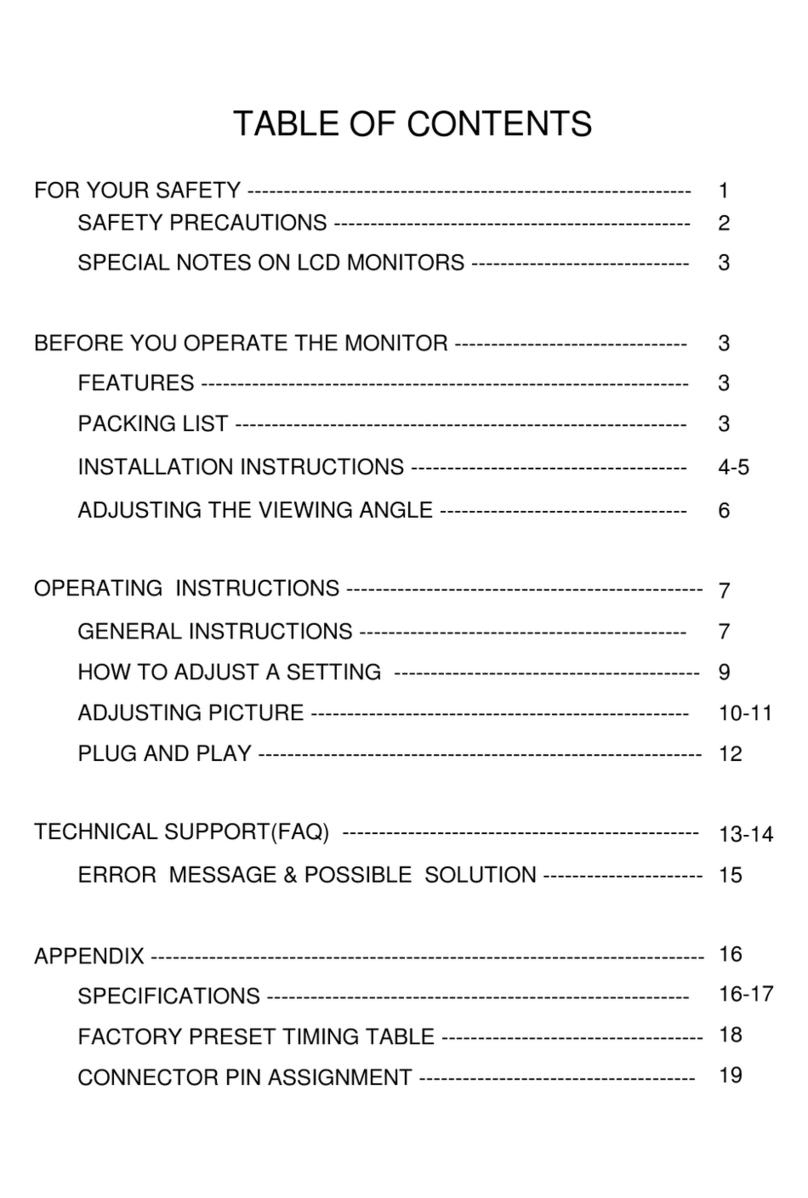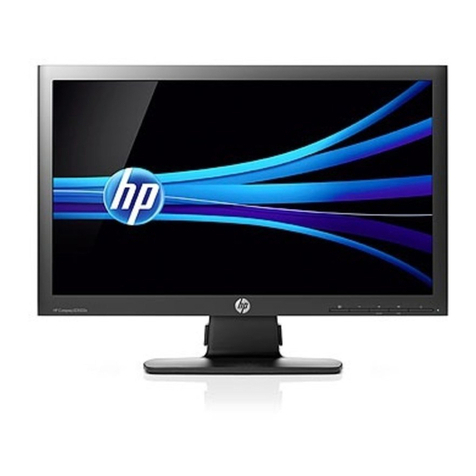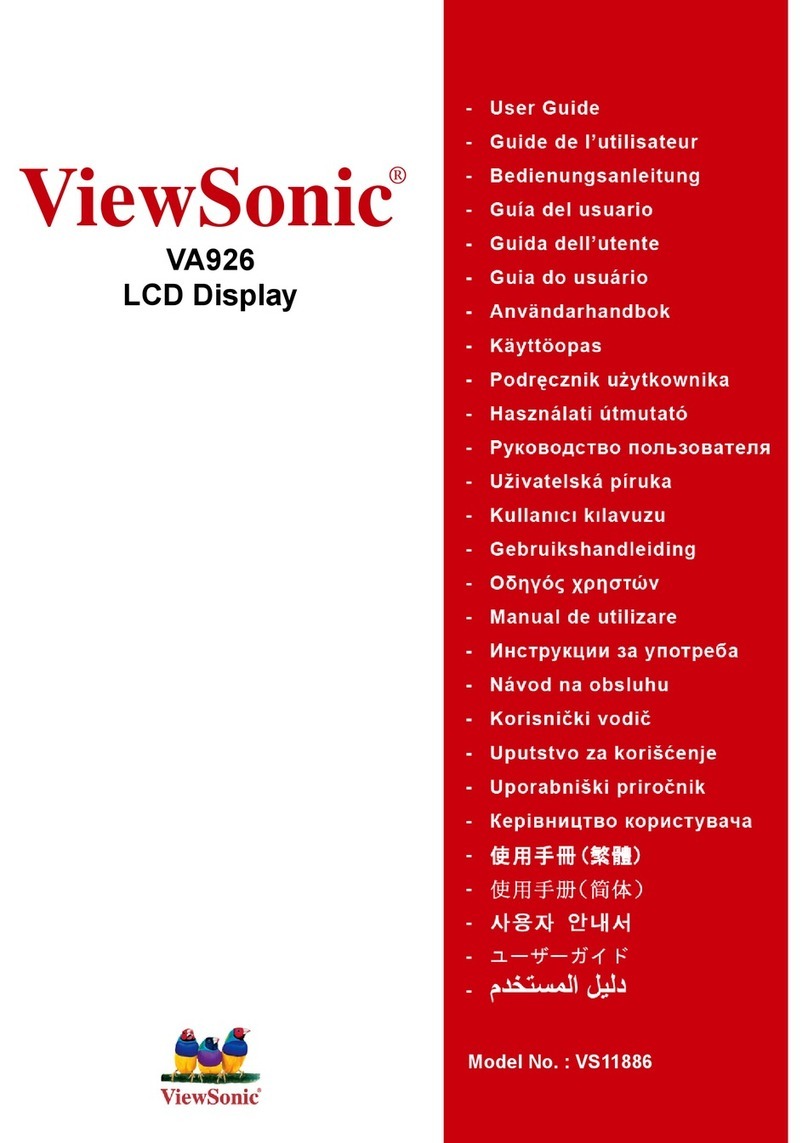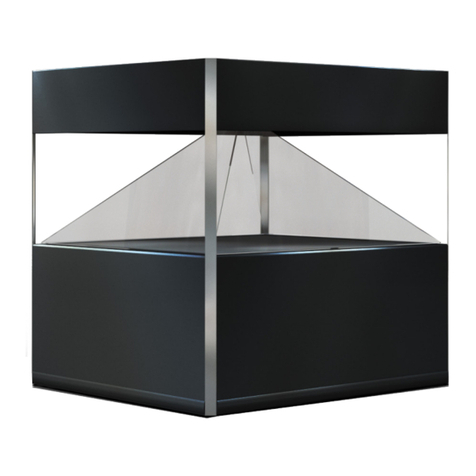Transduction TR-LCD1900-OCD User manual

TRANSDUCTION
USER’S MANUAL
Version 1.0
07/02/09
TR-LCD1900-OCD 19” Rack/Panel Mount
TFT LCD Monitor with Front LCD Controls
5155-23 Spectrum Way, Mississauga, ON, Canada L4W 5A1
TEL: 1-800-268-0427, 905-625-1907
F AX: 905-625-0531
Email: [email protected]

Important Information
The information in this document is subject to change without notice.
All relevant issues have been considered in the preparation of this document. Should you notice an omission or
any questionable item in this document, please feel free to notify Transduction.
Regardless of the foregoing statement, Transduction assumes no responsibility for any errors that may appear in
this document nor for results obtained by the user as a result of using this product.
Copyright © 2009 Transduction. All rights reserved.
This document is protected by copyright. No part of this document may be reproduced, copied or translated in any
form or means without prior written permission from Transduction.
All other trademarks, brand and product names are the property of their respective owners.
Return policy
Products returned for repair must be accompanied by a Return Material Authorization (RMA) number, obtained
from Transduction prior to return. Freight on all returned items must be prepaid by the customer. The customer is
responsible for any loss or damage caused by the carrier in transit.
To obtain an RMA number, call us at 905-625-1907. We will need the following information:
•Return company address and contract
•Model name, model number and serial number
•Description of the failure
Mark the RMA number clearly on the outside of each box, include a failure report and return the product to:
Transduction
5155 – 23 Spectrum Way
Mississauga ON Canada L4W 5A1
Attn: RMA Department

When not used for extended periods of time, set your PC to DPMS. If using a
screen saver, set it to the active screen mode.
Do not use a damaged or loose plug. This may cause an electric shock or fire.
Do not pull the plug out by the wire or touch the plug with wet hands. This may
cause an electric shock or fire.
Use only a properly grounded plug or receptacle. An improper ground may
cause electric shock or equipment damage.
Do not excessively bend the plug and wire or place heavy objects on them. This
could cause damage and an electric shock or fire.
Do not place the monitor face down. The CDT surface may be damaged.
When cleaning, wipe with a slightly moistened, soft cloth. Do not spray any
cleaner directly on to the monitor.
Do not remove housing. No serviceable p arts inside. Refer servicing to Trans-
duction.
Safety Precautions
1
TR-LCD1900-OCD User Manual

Contents
Your new TR-LCD1900-OCD monitor box should contain the
following:
•TR-LCD1900-OCD rack mount / panel mount monitor
•Power Cord
•Video Signal Cable
•User’s Manual and Driver Inst allation CD
*Remembertosave your original box and packing material to transport or ship the monitor.
Power Cord
Video Signal Cable
User’s Manual and Driver
Installation CD
2
TR-LCD1900-OCD User Manual

Quick Start
To attach the TR-LCD1900-OCD monitor to your system, follow these instructions:
1. Turn off the power to your computer.
2. Connect the power cord for your monitor to the power port on the back of the monitor . Plug the power
cord for the monitor into a nearby outlet.
3-1. Using the D-sub (analog) connector on the video card:
Connect the signal cable to the 15-pin, D-sub connector on the back of your monitor .
3-2. Using the DVI (digital) connector on the video card:
Connect the DVI cable to the DVI port on the back of your monitor .
4. Connect to a Macintosh:
Use the D-sub connection cable.
(An older model Macintosh may require a special Mac adaptor).
5. Turn on your computer and monitor. If your monitor displays an image, inst allation is complete.
NOTES:
•You may get a blank screen depending on the type of video card you are using, if you connect
simultaneously both D-sub and DVI cables to one computer.
•If the monitor is connected properly using the DVI connector but you get a blank or fuzzy
screen, check to see if monitor status is set to analog. Press Source button to have the monitor
double-check the input signal source.
3
TR-LCD1900-OCD User Manual

Control Panel Buttons
Accessing the menu system
1. With the OSD off, push the Menu button to activate the main OSD menu.
2. Use the Up or Down buttons to move from one function to another . As you move from one
icon to another, the function name changes to reflect the function or group of functions
represented by that icon. Please refer to the following table for a complete list of all of the
functions available for the driver board.
3. Press the Set button once to activate the highlighted function, use the Up or Down buttons to
select the function.
4. After selecting a function, use the - or + buttons to make optimum adjustments. The setting bar
moves and the numeric value indicator changes to reflect your adjustments.
Note: The numeric value indicator is provided as a point of reference only and has nothing to
do with a real measurement.
5. Press the Menu button once to return to the main menu to select another function or press
twice to exit from the OSD.
The Control Panel Buttons give various and very easy graphic user interfaces. Users can easily
access the function needed. Be sure that your system power and LED is turned on before operating
the keyboard.
Key Name and Function
Key Name Description
Power Turns ON/OFF the system
Menu Activates the OSD menu or goes to previous menu
Auto -When the OSD menu is off, press more than 3 seconds
: Performs “Auto-adjustment” function
-When the OSD menu is on
: Selects the highlighted icon that user wants
Down Moves the highlight icon up to the function that user wants
Up Moves the highlight icon down to the function that user wants
Left Decreases the adjustment of the selected function
Right Increases the adjustment of the selected function
Source Selects the Input Signal among analog RGB, Digital DVI, CVBS and S-VHS
4
TR-LCD1900-OCD User Manual

Control Panel Buttons cont’d
OSD Adjustment
Menus Sub-menus Function Descriptions
Brightness Adjusts the brightness of video.
Contrast Adjusts the contrast of video.
Clock Removes the noises. When frequency value is wrong, the image
has horizontal lines especially in 1 dot on and off.
Phase Removes the noises. When phase value is wrong, the image
has vertical lines especially in 1 dot on and off.
Adjustment (PC)
Adjustment is used
to fine tune and get
the best image by
removing noises
that creates
unstable images
with jitters and
shimmers.
Auto Adjust “Auto adjustment” allows the monitor to self-adjust to the
incoming video signal. The value of phase, frequency and
position are adjusted automatically.
Contrast Adjusts the contrast of image.
Adjustment (DVI)
This function is
active if you select a
digital DVI source
Brightness Adjusts the brightness of image.
Brightness Adjusts the brightness of video.
Contrast Adjusts the contrast of video.
Color Changes the richness of color.
Tint Changes the tone of color.
Adjustment
(Video)
This function is
active if you select
an input source
other than PC.
(DVD,VCR)
Sharpness Adjusts the sharpness of video image.
6500° K Reddish white.
9200° K Bluish white.
Color
The color can be
changed from
reddish to bluish
white.
User User customizable.
Image -H Position : Adjusts the horizontal position of the image.
-V Position : Adjusts the vertical position of the image.
-GAMMA : Bypass
-Information : Displays current display mode.
OSD -Language : English, Germany, French, Italy, Spanish.
-Color : Changes the opaqueness of the OSD background.
-Position : Moves the OSD Window.
-Duration : Indicates time until the OSD Menu will disappear
after adjusting the menu.
-OSD Lock : Avoids OSD control except HOT key.
Mode
Recall
Changes the image information to factory outgoing status.
Backlight Changes the brightness of image by controlling the backlight of
panel.
Setup
Setup is used to
adjust OSD menu
information and
image.
Auto sleep Goes to soft power off after 10 minutes when input cable is
disconnected.
5
TR-LCD1900-OCD User Manual

Rear Panel Connectors and On/Off Switch
(The configuration at the back of the monitor may vary from product to product.)
1 Power port Connect the power cord for your monitor to the power
port on the back of the monitor.
2 DVI port Connect the DVI Cable to the DVI Port on the back of
your Monitor.
3 Signal port Connect the signal cable to the 15-pin, D-sub connector
on the back of your monitor.
Note: See Quick Start on page 4 for further information regarding cable connections.
6
TR-LCD1900-OCD User Manual

Troubleshooting Tips
Before calling for service, check the information
in this section to see if you can remedy any
problems yourself. If you do need assistance,
please contact Transduction.
Symptom Check List Solutions
Is the power cord connected
properly?
Check the power cord connection and supply.
Can you see “No Connection,
Check Signal Cable” on the
screen?
(Connected using the D-sub cable)
Check the signal cable connection.
(Connected using the DVI cable)
If you still see an (error) message on the screen when the monitor is
connected properly, check to see if the monitor status is set to analogue.
Press Source button to have the monitor double-check the input signal
source.
If the power is on, reboot the
computer to see the initial screen
(the login screen), which can be
seen.
If the initial screen (the login screen) appears, boot the computer in the
applicable mode (the safe mode for Windows ME/2000/XP) and then
change the frequency of the video card.
(Refer to the Preset Display Modes page 32)
Note: If the initial screen (the login screen) does not appear, contact a
service center or your dealer.
Can you see “Video mode not
supported” on the screen?
You can see this message when the signal from the video card exceeds
the maximum resolution and frequency that the monitor can properly
handle.
Adjust the maximum resolution and frequency that the monitor can
properly handle.
There is no image on the screen. Is
the power indicator on the monitor
blinking at 1 second intervals?
The monitor is in PowerSaver mode.
Press a key on the keyboard or move the mouse to activate the monitor
and restore the image on the screen.
If there is still no image, press the ‘Source’ button. Then press any key on
the keyboard or move the mouse again to activate the monitor and restore
the image on the screen.
No images on the screen. I
cannot turn on the
monitor.
Connected using the DVI cable? You may get a blank screen if you boot the system before you connect the
DVI cable, or disconnect and then reconnect the DVI cable while the
system is running as certain types of graphic cards do not send out video
signals. Connect the DVI cable and then reboot the system.
I cannot see the On Screen
Display.
Have you locked the On Screen
Display (OSD) Menu to prevent
changes?
Unlock the OSD by pressing the MENU button for at least 5 seconds.
Is the screen displaying only one
color as if looking at the screen
through cellophane paper?
Check the signal cable connection.
Make sure the video card is fully inserted in its slot.
Have the screen colors become
strange after running a program or
due to a crash between applications?
Reboot the computer.
The screen shows strange
colors or just black and
white.
Has the video card been set
properly?
Set the video card by referring to the video card manual.
Have you changed the video card or
the driver?
Adjust screen image position and size using the OSD or MagicTune.
Have you adjusted the resolution or
frequency to the monitor?
Adjust the resolution and frequency at the video card.
(Refer to the Preset Display Modes page 32).
The screen suddenly has
become unbalanced.
The screen can be unbalanced due to the cycle of the video card signals. Readjust Position by referring to
the OSD or MagicTune.
The screen is out of focus
or OSD cannot be
adjusted.
Have you adjusted the resolution or
frequency on the monitor?
Adjust the resolution and frequency of the video card.
(Refer to the Preset Display Modes page 32).
LED is blinking but no
images on the screen.
Is the frequency properly adjusted
when checking the Display Timing on
the menu?
Adjust the frequency properly by referring to the video card manual and
the Preset Display Modes.
(The maximum frequency per resolution may differ from product to
product.)
Have the Windows colors been set
properly?
For Windows ME/2000/XP:
Set the colors properly at the Control Panel, Display, Settings.
There are only 16 colors
shown on the screen. The
screen colors have
changed after changing
the video card.
Has the video card been set
properly?
Set the video card by referring to the video card manual.
Have you installed the monitor
driver?
Install the monitor driver according to the Driver Installation Instructions.There is a message that
reads “Unrecognized
monitor, Plug & Play
(VESA DDC) monitor
found”.
See the video card manual to see if
the Plug & Play (VESA DDC)
function can be supported.
Install the monitor driver according to the Driver Installation Instructions.
7
TR-LCD1900-OCD User Manual

Troubleshooting Tips - cont’d
Frequently Asked Questions
Check the following items if there is trouble with the monitor.
1. Check if the power cord and the cable are properly connected to the computer.
2. Check if the computer beeps more than 3 times when booting.
(If it does, request an af ter-service for the main board of the computer .)
3. If you installed a new video card or if you assembled the PC, check if you installed the
adapter (video) driver.
4. Check if the scanning ratio of the video screen is set at 75Hz.
(Do not exceed 60Hz when using the maximum resolution.)
5. If you have problems in inst alling the adapter (video) driver, boot the computer in Safe
Mode, remove the Display Adapter from the hardware profile and then reboot the computer
and reinstall the adapter (video) driver .
Check Before Using MagicTuneTM
1. The MagicTuneTM (display adjustment) feature is not available in Game mode or Full Screen
video mode.
2. When activated in a mode in which the four edges of the display are black (Game or DOS
mode), the “Auto” feature of the LCD monitor may cause the screen to be displayed of f-
center.
3. Installing the MagicTuneTM (display adjustment) software may cause a slight delay when
starting the computer.
Question Answer
How can I change the frequency? Frequency can be changed by reconfiguring the video card.
Note that video card support can vary, depending on the version of
the driver used.
(Refer to the computer or the video card manual for details.)
How can I adjust the resolution? Windows ME/XP/2000 : Set the resolution at the Control Panel,
Display, Settings.
How can I set the Power Saving function? Windows ME/XP/2000 : Set the function from the Control Panel,
Display, Screen Saver.
How can I clean the outer case / LCD Panel? Clean the monitor with a soft cloth, using either a cleaning solution or
plain water. Do not spray directly on to the monitor.
8
TR-LCD1900-OCD User Manual

Self-Test Feature
The TR-LCD1900-OCD has a Self-Test feature that allows you to check whether your monitor is
functioning properly.
Self-Test Feature Check
1. Turn off both your computer and the monitor.
2. Unplug the video cable from the back of the computer .
3. Turn on the monitor.
If the monitor is functioning properly, you will see a box with a border and text inside as shown in
the following illustration:
The three boxes inside the border are red, green and blue.
Failure of any of the boxes to appear indicates a problem with your monitor . This box also ap-
pears during normal operation if the video cable becomes disconnected or damaged.
1. Turn off your monitor and reconnect the video cable; then turn on both your computer and the
monitor.
If your monitor remains blank after following the previous procedure, check your video controller
and computer system; your monitor is functioning properly .
Warning Messages
If there is something wrong with the input signal, a message appears on the screen or the screen
goes blank. The message may indicate that the monitor is out of scan range or that you need to
check the signal cable.
Useful Tips
•A monitor recreates visual signals received from the PC. Therefore, if there is trouble with
the PC or the video card, this can cause the monitor to become blank, have poor coloring,
noise, Video mode not supported, etc.
•Judging the monitor’s working condition
If there is no image on the screen or “Video mode not supported” message comes up, discon-
nect the cable from the computer while the monitor is still powered on.
oIf there is a message coming up on the screen or if the screen goes white, this means
the monitor is in working condition.
oIn this case, check the computer for trouble.
9
TR-LCD1900-OCD User Manual

TR-LCD1900-OCD Specifications
Note: Design and specifications are subject to change without prior notice.
TR-LCD1900-OCD Monitor Notes
LCD Module
Size:
Display Area:
Pixel Pitch:
Type:
Viewing Angle:
Brightness:
Contrast Ratio:
19.0 inch diagonal
376.32 (H) x 301.056 (V)
0.294 (H) x 0.294 (V)
a-si TFT active matrix
80(H) / 75(V)
300 cd/m2
700 : 1
Active matrix, thin film transistor
(TFT) liquid crystal display
(LCD)
Synchronization
Horizontal:
Vertical:
30 ~ 81 kHz
56 ~ 75 Hz
Automatically
Automatically
Display Colors
Analog input:
16,194,277
Dependent on display card
used.
Resolution
Optimum resolution:
Maximum resolution:
1280 x 1024@60Hz
1280 x 1024@75Hz
See Other Resolutions
Supported on page 11 for
complete list
Input Signal, Terminated
RGB Analog, DVI Compliant Digital RGB.
Composite H/V Sync, SOG(option), 0.7Vp-p Positive at 75 ohms
Separate H/V sync, TTL level positive or negative
Maximum Pixel Clock 140 MHz
Power Supply AC 90 ~ 264 VAC rms, 60/50 Hz ± 3Hz or optional 12VDC input
Power Consumption 42W (Maximum)
Signal Cable 15pin-to-15pin D-sub cable, detachable
DVI-D to DVI-D connector, detachable
Dimensions (W x D x H) / Weight
Rack mount:
Panel mount:
18.96” x 2.875” x 15.75” (9U) / 14.3 lb
48.16cm x 7.3cm x 40.01cm / 6.5 kg
17.75” x 3.00” x 15.25” / 14 lb
45.09cm x 7.62cm x 41.70cm / 6.35 kg
Environmental Considerations
Operating Temperature:
Humidity:
Storage Temperature:
Humidity:
32°F ~ 122°F (0°C ~ 50°C)
10% ~ 80%, non-condensing
-4°F ~ 140°F (-20°C ~ 60°C)
5% ~ 95%, non-condensing
Vibration & Shock 5G/30G
Plug and Play Capability This monitor can be installed on any Plug & Play compatible system. Interaction of
the monitor and computer systems will provide the best operating conditions and
monitor settings. In most cases, monitor installation will proceed automatically,
unless the user wishes to select alternate settings.
Dot Acceptability TFT LCD panel is manufactured by using advanced semiconductor technology with
precision of 99.999% above is used for this product. But the RED, GREEN, BLUE
and WHITE color pixels may seem to be bright sometimes or some black pixels
could be seen. This is normal.
For example, the no. of TFT LCD pixels that is contained in this product are
3,932,160.
MagicTune Display Adjustment
Feature
For Windows 98SE or later.
Regulatory Approvals CSA
FCC Class A CE
UL
10
TR-LCD1900-OCD User Manual

Display Mode Horizontal
Frequency
(kHz)
Vertical
Frequency
(Hz)
Pixel Clock
(MHz) Sync Polarity
(H/V)
IBM, 640 x 350 31.469 70.086 25.175 +/-
IBM, 640 x 480 31.469 59.940 25.175 -/-
IBM, 720 x 400 31.469 70.087 28.322 -/+
MAC, 640 x 480 35.000 66.667 30.240 -/-
MAC, 832 x 624 49.726 74.551 57.284 -/-
VESA, 640 x 480 37.500 75.000 31.500 -/-
VESA, 640 x 480 37.861 72.809 31.500 -/-
VESA, 800 x 600 35.156 56.250 36.000 +,-/+,-
VESA, 800 x 600 37.879 60.317 40.000 +/+
VESA, 800 x 600 46.875 75.000 49.500 +/+
VESA, 800 x 600 48.077 72.188 50.000 +/+
VESA, 1024 x 768 48.363 60.004 65.000 -/-
VESA, 1024 x 768 56.476 70.069 75.000 -/-
VESA, 1024 x 768 60.023 75.029 78.750 +/+
VESA, 1280 x 1024 63.981 60.020 108.00 +/+
VESA, 1280 x 1024 79.976 75.025 135.00 +/+
SUN, 1280 x 1024 81.129 76.106 135.00 -/-
Resolutions Supported
Horizontal Frequency
The time to scan one line connecting the right edge to the left edge of the screen horizontally is
called Horizontal Cycle and the inverse number of the Horizontal Cycle is called Horizontal
Frequency. Unit: kHz
Vertical Frequency
Like a fluorescent lamp, the screen has to repeat the same image many times per second to
display an image to the user. The frequency of this repetition is called Vertical Frequency or
Refresh Rate. Unit: Hz
If the signal transferred from the computer is the same as the following Preset Timing Modes, the
screen will be adjusted automatically. However, if the signal differs, the screen may go blank while
the power is on. Refer to the video card manual and adjust the screen as follows.
Preset Timing Modes
11
TR-LCD1900-OCD User Manual

TRANSDUCTION
5155 Spectrum Way Bldg 23
Mississauga, ON
L4W 5A1
Canada
905-625-1907
www.transduction.com
12
TR-LCD1900-OCD User Manual






Table of contents
Other Transduction Monitor manuals
